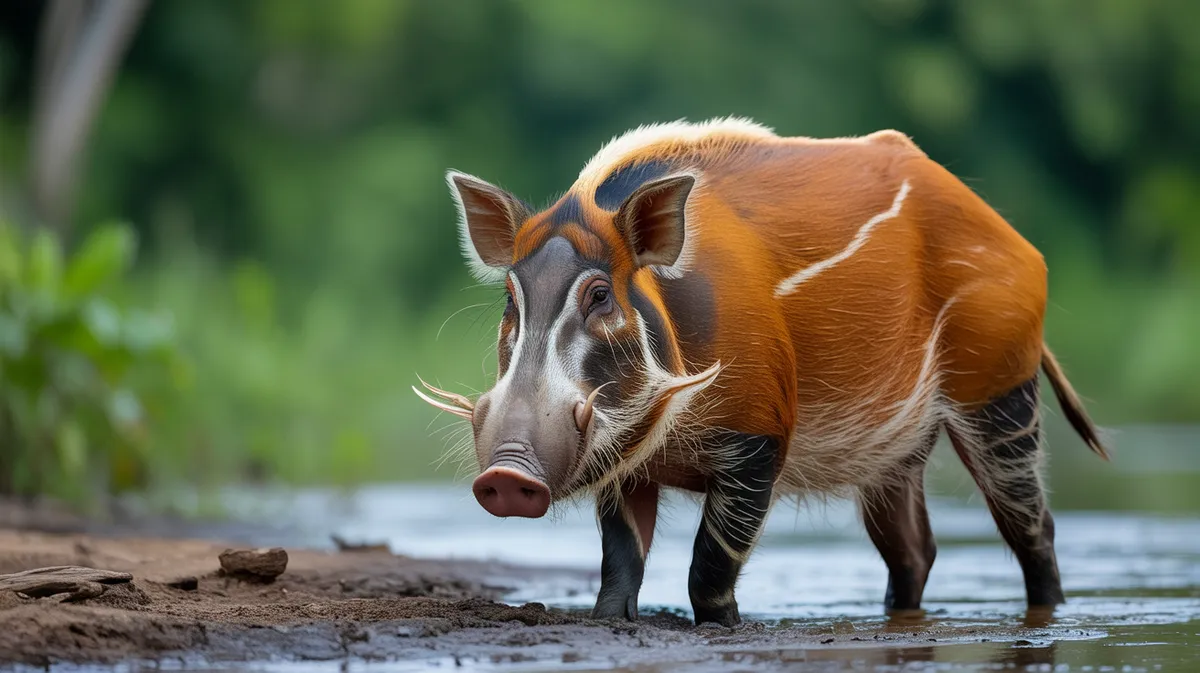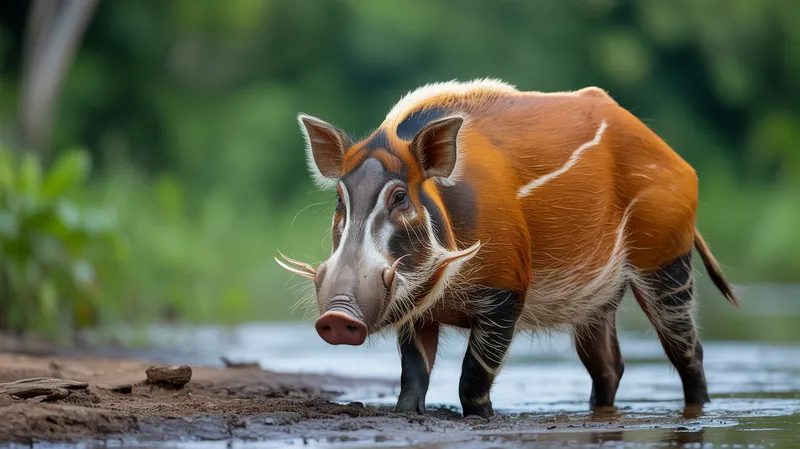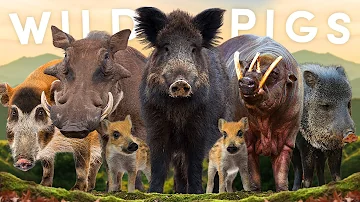
Red River Hog
Potamochoerus porcus

Meet the Red River Hog
The Red River Hog is a striking wild pig native to the forests and savannas of West and Central Africa. Distinguished by its bright reddish-orange coat, black legs, and distinctive white facial markings, it is one of the most colorful members of the pig family. Red River Hogs are highly social animals, living in groups called sounders and communicating with a variety of grunts and squeals. They are mostly nocturnal and are known for their excellent sense of smell, which they use to locate food hidden beneath the soil.
Classification
Mammal
Habitat
Tropical rainforests, swamps, and wet savannas
Diet
Omnivore
Lifespan
10-20 years
Conservation
Least Concern
Weight
45-115 kg
📖Fascinating Facts
Brightly Colored Coat
The Red River Hog’s vivid orange-red fur and white facial mask help it blend into the dappled light of its dense forest habitat.
Superb Sniffer
This hog uses its highly developed sense of smell to root out insects, bulbs, roots, fruits, and even small animals hiding underground.
Group Living
Red River Hogs live in groups of up to 20 individuals, led by a dominant male, and rely on teamwork for protection and food finding.
📋Detailed Description
The Red River Hog (Potamochoerus porcus) is a medium-sized wild suid, notable for its vibrant reddish-orange coat, which is accentuated by a dorsal mane of longer, erectile bristles running from the head to the tail. Adults typically measure 100–145 cm (39–57 in) in length, stand 55–80 cm (22–31 in) at the shoulder, and weigh between 45–115 kg (99–254 lbs), with males generally larger than females. Their faces are marked by striking white markings, including a prominent white stripe running down the snout and white tufts on the cheeks and jaw. Males, or boars, possess well-developed facial warts and bony protuberances for protection during fights. The ears are elongated and end in conspicuous white or black tassels. The species is highly adapted to dense, humid environments and is rarely found far from water. Red River Hogs are agile and can swim well, often wallowing in mud to regulate body temperature and deter parasites. Their sense of smell is extremely acute, aiding in foraging and social communication. Sounders, or social groups, typically consist of 6–20 individuals, led by a dominant male and composed of several females and their offspring. The species is primarily nocturnal or crepuscular, with activity peaking at dawn and dusk, although diurnal activity is not uncommon in undisturbed areas.
💡 Did you know?
Despite their wild appearance, Red River Hogs can sometimes interbreed with other wild pig species, such as the bushpig, in areas where their ranges overlap.
🔬Research & Sources
Wikipedia Summary
The red river hog or bushpig is a wild member of the pig family living in Africa, with most of its distribution in the Guinean and Congolian forests. It is rarely seen away from rainforests, and generally prefers areas near rivers or swamps.
Last Modified: 5/9/2025
🎭Behavior & Social Structure
Red River Hogs are omnivorous and opportunistic feeders, rooting through soil and leaf litter with their strong snouts to unearth roots, tubers, bulbs, fallen fruit, fungi, insects, small vertebrates, eggs, and carrion. They have been observed raiding agricultural fields for crops such as cassava and maize. Foraging is a highly social activity, often accompanied by a chorus of grunts, squeals, and snorts used for communication and coordination. Social bonds within sounders are strong, with frequent grooming and close physical contact. Dominance hierarchies are maintained primarily among males, especially during the breeding season, through ritualized displays and occasional combat. Red River Hogs are known to wallow in mud and water to cool off and deter ectoparasites. They are generally shy and elusive in the wild, relying on dense vegetation for cover, but may become bolder in protected areas or near human settlements.
👶Reproduction & Life Cycle
Breeding in Red River Hogs typically occurs during the late dry season or early rainy season, though timing can vary regionally. Males compete for access to females, engaging in displays and sometimes physical confrontations. After successful mating, the gestation period lasts approximately 120–127 days (about 4 months). Females construct elaborate nests from vegetation in dense thickets, where they give birth to litters of 2–6 piglets, with 3–4 being most common. Newborns are precocial, with distinctive brown and yellow longitudinal stripes that provide camouflage. Piglets are nursed for 2–4 months and begin foraging with the group within a few weeks. Maternal care is pronounced, with females fiercely defending their young. Sexual maturity is reached at 18–24 months. In the wild, lifespan is typically 10–12 years, but individuals in captivity may live up to 20 years.
🛡️Adaptations & Survival
Red River Hogs possess several adaptations for survival in dense, humid forests. Their keen sense of smell and strong, flexible snout allow efficient rooting and foraging in leaf litter and soft soils. The bright coloration and facial markings may serve as visual signals for intra-species recognition in low-light environments. The erectile dorsal mane is raised during displays of aggression or excitement, making the animal appear larger. Their elongated, tassel-tipped ears may help in communication and possibly in deterring insects. Behavioral adaptations include group living for protection against predators and cooperative care of young. Their ability to swim and wallow in mud helps regulate body temperature and avoid parasites. The species’ generalist diet and flexible foraging strategies allow them to exploit a wide range of food resources.
📚Research Sources
🎨Cultural Significance
Red River Hogs feature in the folklore and traditional practices of several West and Central African cultures. They are often associated with fertility and abundance due to their prolific breeding and foraging habits. In some communities, their meat is considered a delicacy and plays a role in ceremonial feasts. The animal’s striking appearance has made it a symbol of the wild forests in local storytelling. However, they are also viewed as agricultural pests and may be subject to control measures in farming areas.
🔬Recent Research & Discoveries
Recent research has focused on the genetic diversity and phylogeography of Potamochoerus porcus, revealing significant regional variation and possible subspecies differentiation. Studies of their role in forest ecology highlight their importance as seed dispersers and ecosystem engineers, influencing plant community dynamics through rooting and foraging. Ongoing investigations are examining the impact of disease transmission between wild and domestic pigs, particularly in relation to African swine fever outbreaks. Behavioral studies using camera traps and GPS telemetry have provided new insights into their movement patterns, habitat use, and responses to human disturbance. Conservation genetics is also being employed to inform management strategies in fragmented landscapes.
🎥Wildlife Videos

Red River Hog Feeds Her Tiny Newborn Piglets | The Secret Life of the Zoo | Nature Bites
Mother Mali gives birth to three new piglets and immediately teaches them some discipline, especially around mealtimes.
Nature Bites

All 20 Wild Pig Species (& Their Piglets!)
Red River hog https://nationalzoo.si.edu/animals/red-river-hog https://www.sciencefocus.com/nature/red-river-hog ...
Textbook Travel

Red River Hogs: An Elusive Wild Pig
The red river hog, also known as the bush pig, is a medium-sized species of wild pig that gets its name from the vibrant ...
Familiarity With Animals (FWA)

Red river hog family - African Parks - Odzala Kokoua NP - Congo
Camera Traps - Africa

The Red River Hog
NATIONAL ZOOLOGICAL GARDEN PRETORIA, SOUTH AFRICA.
NATIONAL ZOOLOGICAL GARDEN, PRETORIA Official site

World Of Animals:red river hog
The Red River Hog also known as the bush pig but not to be confused with the P. larvatus common name bushpig is a wild ...
Africa nature
🌍Habitat Information
The Red River Hog typically inhabits Tropical rainforests, swamps, and wet savannas environments. Red River Hogs have adapted to their environments with specialized features and behaviors.
Primary Habitat:
Tropical rainforests, swamps, and wet savannas
More detailed habitat information will be available soon.
🛡️Conservation Status
The Red River Hog is currently classified as Least Concern. Conservation efforts are crucial for preserving this species for future generations.
Common Threats:
- 🏠Habitat loss and fragmentation
- 🌡️Climate change impacts
- 🎯Hunting and poaching
- 🏭Human-wildlife conflict
⚠️Threats & Conservation Challenges
Currently classified as Least Concern by the IUCN, Red River Hog populations remain stable across much of their range, though localized declines have been reported. Major threats include habitat loss and fragmentation due to deforestation, agricultural expansion, and infrastructure development. They are also hunted for bushmeat and may be persecuted as crop pests. Disease transmission from domestic pigs, such as African swine fever, poses a significant risk, especially in areas where wild and domestic suids overlap. Despite these challenges, the species’ adaptability and reproductive capacity have allowed it to persist in many disturbed habitats. Ongoing monitoring is necessary to detect potential declines, particularly in regions experiencing rapid land-use change.
🔬Scientific Classification
Scientific Name
Potamochoerus porcus
Classification Hierarchy
🔍 About Taxonomic Classification
Taxonomic classification is a hierarchical system used by scientists to classify and organize living organisms based on shared characteristics and evolutionary relationships.
The system moves from broad categories (Kingdom) to increasingly specific ones, with each animal's scientific name typically consisting of its Genus and species.
📝Community Notes
Share your observations and insights about the Red River Hog with our community of wildlife enthusiasts.
Join Our Community
Sign in to share your observations and connect with fellow wildlife enthusiasts.
Sign In to ContributeNo community notes yet
Be the first to share your observations about the Red River Hog!
Explore Red River Hog
Select a tab above to learn more about this amazing animal.
📸Photo Gallery
No photos available for this animal yet.
🌟Discover More Wildlife
Continue your journey of discovery with more fascinating animals from our database
